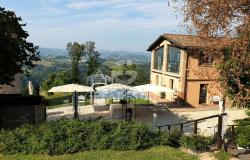Culatello, one of the most prized salumi (cured meats) of Italy, produced in the flatlands north of Parma, near the Po River in Emilia-Romagna, is the subject of a newly opened museum at the Antica Corte Pallavicina in Polesine Parmense.
Called “Museo del Culatello e del Masalen”, it is, in the words of the Antica Corte Pallavicina owners, Massimo and Luciano Spigaroli, a museum dedicated to the territory where culatello is produced, to its people, its culture and history.
Indeed, Culatello di Zibello is the result of the unique micro-climate of the “low lands” near the Po river, known as “la bassa parmense”: long, cold, humid winters, shrouded in fog, a determining factor for the aging of culatello, and sweltering summers. Only eight towns here can produce culatello: Busseto, Polesine Parmense, Zibello, Soragna, Roccabianca, San Secondo, Sissa and Colorno.
The Spigaroli family, now one of the most famous names in Italy for the production of culatello, started as sharecroppers for opera composer Giuseppe Verdi; their Antica Corte Pallavicina is now a relais and a Michelin-starred restaurant.
The museum traces the history of the Spigaroli family, and of the history of culatello, explaining what’s behind the process that makes this salume, made from the leanest part of the thigh of selected local pigs, so prized, soft, with a sweet and velvety flavor. There are panels dedicated to salt, to pigs and their close relationship with farmers’ families, with insights on the typical black pig of Parma, to the main cured meats produced in the area of the Bassa parmense. There are also ancient maps, documents, photographs, films, multimedia equipment and objects related to the local farmer’s culture.
“Peasants in the summer, butchers in the winter, we were one of those families, and now another dream has come true, thanks to an itinerary rich in history that winds through the entire village of Corte Pallavicina, whose recovery began in the 1990s,” says chef Massimo Spigaroli.
Worth stopping by when you visit the Parma area, heart of Emilia-Romagna’s Food Valley, where some of the most famous Italian products are made, including Parmigiano Reggiano, whose museum is 10 minutes from the Museum of Culatello, in Soragna.
For more information, visit the Antica Corte Pallavicina website.



